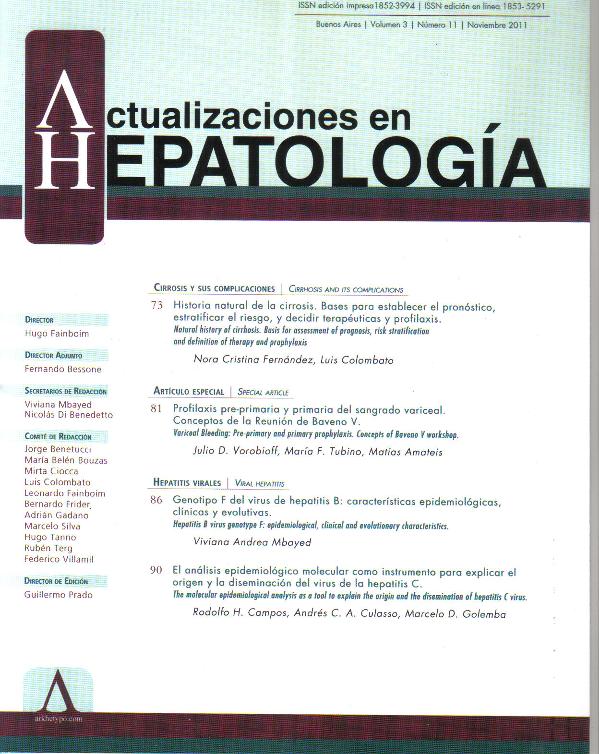Artículo
La posibilidad de obtener y analizar secuencias del virus de la hepatitis C (HCV) ha sido fundamental para el estudio epidemiológico y evolutivo. El análisis filogenético permitió definir a los seis genotipos del HCV y determinar un origen y diversificación asociado a una región geográfica particular. Actualmente se considera que los genotipos de HCV infectan al ser humano desde hace miles de años con un carácter endémico y baja transmisión, pero en condiciones propicias produce brotes emergentes. La factibilidad de transmisión se modificó en el último siglo como resultado del proceso de globalización mundial haciendo posible la “emergencia” de infecciones virales, entre ellas del HCV-1. En la Argentina se analizó de manera comparativa la historia epidemiológica en Buenos Aires y en dos ciudades rurales pequeñas. Se determinaron diferencias en el origen de la infección, la edad de la emergencia, el tiempo en que se expandió la infección. Estas diferencias se explican en la factibilidad de transmisión entre una gran ciudad cosmopolita y un pequeño pueblo rural. Además el carácter monofilético y el tiempo de emergencia más tardío (aprox. 30 años) sugieren que distintos ancestros del HCV-1b (variantes), que ya estaban en plena expansión en Buenos Aires, tuvieron la oportunidad de colonizar pequeñas poblaciones. Estudios similares realizados en Cruz del Eje y en la Provincia de Córdoba sugieren que el HCV-2c fue introducido por la inmigración Italiana a principios del siglo XX y que emergió en los ‘50 estabilizándose 20 años más tarde. The technical advance in acquisition and analysis of sequences of hepatitis C virus (HCV) has improved the research of the virus epidemiology and evolution. The phylogenetic analysis allowed the definition of the six HCV genotypes and the determination of the source and geographical pattern of diversification. Currently, it is thought that the HCV genotypes have infected the mankind for thousands of years in a endemic fashion with low transmission rates, but outbreaks could emerge under certain conditions. The world globalization process had made possible the emergence of viral infections, like HCV-1, according to the increased factibility of the viral transmission. The comparative analyses of the epidemiological history of this infection were carried out in Argentina, in Buenos Aires and two small rural cities. We observed differences between the infection source, the time of the emergence and the time when the infection was spread. These differences could be explained by the dissimilar opportunity of transmission within a big city as Buenos Aires and small rural towns. Furthermore, the monophyly and the older time of emergence in the small towns suggest that several HCV-1b ancestors, which were already in expansion in Buenos Aires, could colonize these towns. Similar studies on HCV-2c isolated in “Cruz del Eje” and in other cities and towns of the Province of Córdoba suggest that this subtype was introduced in the country by the Italian immigration at the begging of the XXth Century, then it emerged in the ‘50s and stopped its spreading in the ‘70s.
El análisis epidemiológico molecular como instrumento para explicar el origen y la diseminaciń del virus de la hepatitis C
Título:
The molecular epidemiological analysis as a tool to explain the origin and the disemination of hepatitis C virus
Fecha de publicación:
11/2011
Editorial:
Arkhetypo
Revista:
Actualizaciones en Hepatología
ISSN:
1852-3994
Idioma:
Español
Tipo de recurso:
Artículo publicado
Clasificación temática:
Resumen
Palabras clave:
Virus de La Hepatitis C
,
Epidemiología Molecular
,
Filogenia
Archivos asociados
Licencia
Identificadores
Colecciones
Articulos(OCA HOUSSAY)
Articulos de OFICINA DE COORDINACION ADMINISTRATIVA HOUSSAY
Articulos de OFICINA DE COORDINACION ADMINISTRATIVA HOUSSAY
Citación
Campos, Rodolfo Hector; Culasso, Andrés Carlos Alberto; Golemba, Marcelo Darío; El análisis epidemiológico molecular como instrumento para explicar el origen y la diseminaciń del virus de la hepatitis C; Arkhetypo; Actualizaciones en Hepatología; 3; 11; 11-2011; 90-94
Compartir




